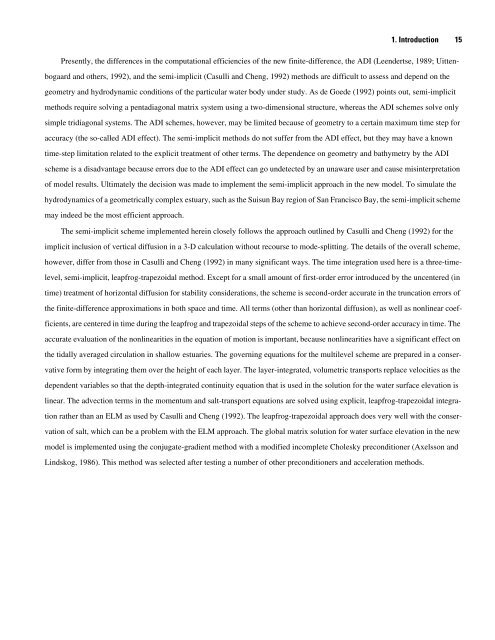A Semi-Implicit, Three-Dimensional Model for Estuarine ... - USGS
A Semi-Implicit, Three-Dimensional Model for Estuarine ... - USGS
A Semi-Implicit, Three-Dimensional Model for Estuarine ... - USGS
Create successful ePaper yourself
Turn your PDF publications into a flip-book with our unique Google optimized e-Paper software.
1. Introduction 15<br />
Presently, the differences in the computational efficiencies of the new finite-difference, the ADI (Leendertse, 1989; Uitten-<br />
bogaard and others, 1992), and the semi-implicit (Casulli and Cheng, 1992) methods are difficult to assess and depend on the<br />
geometry and hydrodynamic conditions of the particular water body under study. As de Goede (1992) points out, semi-implicit<br />
methods require solving a pentadiagonal matrix system using a two-dimensional structure, whereas the ADI schemes solve only<br />
simple tridiagonal systems. The ADI schemes, however, may be limited because of geometry to a certain maximum time step <strong>for</strong><br />
accuracy (the so-called ADI effect). The semi-implicit methods do not suffer from the ADI effect, but they may have a known<br />
time-step limitation related to the explicit treatment of other terms. The dependence on geometry and bathymetry by the ADI<br />
scheme is a disadvantage because errors due to the ADI effect can go undetected by an unaware user and cause misinterpretation<br />
of model results. Ultimately the decision was made to implement the semi-implicit approach in the new model. To simulate the<br />
hydrodynamics of a geometrically complex estuary, such as the Suisun Bay region of San Francisco Bay, the semi-implicit scheme<br />
may indeed be the most efficient approach.<br />
The semi-implicit scheme implemented herein closely follows the approach outlined by Casulli and Cheng (1992) <strong>for</strong> the<br />
implicit inclusion of vertical diffusion in a 3-D calculation without recourse to mode-splitting. The details of the overall scheme,<br />
however, differ from those in Casulli and Cheng (1992) in many significant ways. The time integration used here is a three-time-<br />
level, semi-implicit, leapfrog-trapezoidal method. Except <strong>for</strong> a small amount of first-order error introduced by the uncentered (in<br />
time) treatment of horizontal diffusion <strong>for</strong> stability considerations, the scheme is second-order accurate in the truncation errors of<br />
the finite-difference approximations in both space and time. All terms (other than horizontal diffusion), as well as nonlinear coef-<br />
ficients, are centered in time during the leapfrog and trapezoidal steps of the scheme to achieve second-order accuracy in time. The<br />
accurate evaluation of the nonlinearities in the equation of motion is important, because nonlinearities have a significant effect on<br />
the tidally averaged circulation in shallow estuaries. The governing equations <strong>for</strong> the multilevel scheme are prepared in a conser-<br />
vative <strong>for</strong>m by integrating them over the height of each layer. The layer-integrated, volumetric transports replace velocities as the<br />
dependent variables so that the depth-integrated continuity equation that is used in the solution <strong>for</strong> the water surface elevation is<br />
linear. The advection terms in the momentum and salt-transport equations are solved using explicit, leapfrog-trapezoidal integra-<br />
tion rather than an ELM as used by Casulli and Cheng (1992). The leapfrog-trapezoidal approach does very well with the conser-<br />
vation of salt, which can be a problem with the ELM approach. The global matrix solution <strong>for</strong> water surface elevation in the new<br />
model is implemented using the conjugate-gradient method with a modified incomplete Cholesky preconditioner (Axelsson and<br />
Lindskog, 1986). This method was selected after testing a number of other preconditioners and acceleration methods.

















